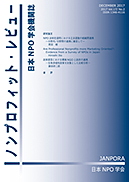Volume 6, Issue 1+2
Displaying 1-4 of 4 articles from this issue
- |<
- <
- 1
- >
- >|
Articles
-
2006 Volume 6 Issue 1+2 Pages 1-13
Published: 2006
Released on J-STAGE: December 19, 2006
Download PDF (772K) -
2006 Volume 6 Issue 1+2 Pages 15-24
Published: 2006
Released on J-STAGE: December 19, 2006
Download PDF (488K) -
2006 Volume 6 Issue 1+2 Pages 25-35
Published: 2006
Released on J-STAGE: December 19, 2006
Download PDF (542K)
Research Notes
-
2006 Volume 6 Issue 1+2 Pages 37-45
Published: 2006
Released on J-STAGE: December 19, 2006
Download PDF (447K)
- |<
- <
- 1
- >
- >|
